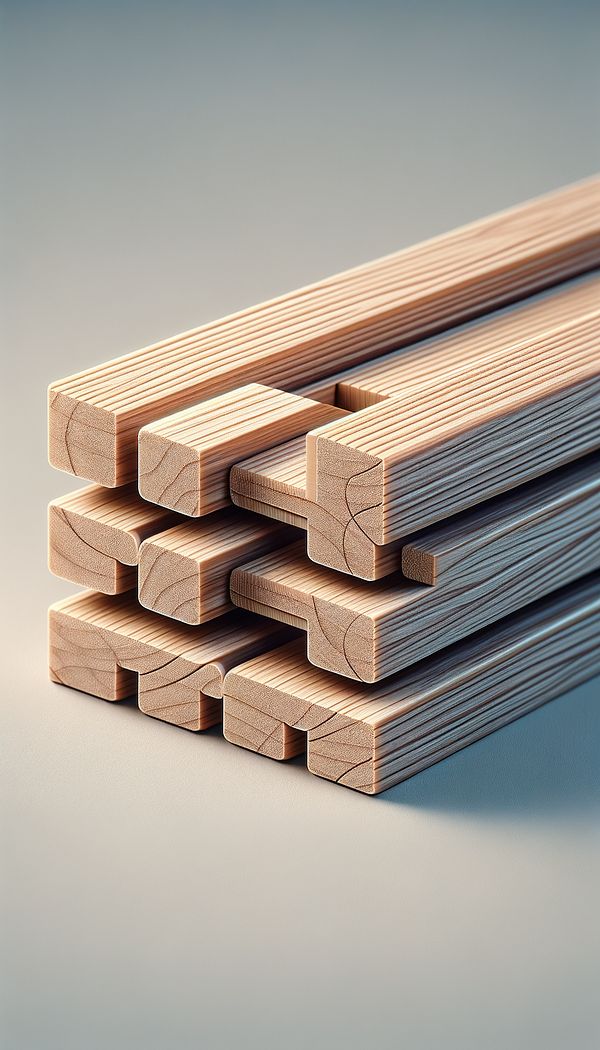What is Tongue & Groove?
Tongue & Groove is a method of fitting similar objects together, edge to edge.
Description
Tongue & Groove refers to a classic joining method widely used in woodworking and construction. This technique involves two complementary pieces: the "tongue" and the "groove". The tongue is a narrow ridge that runs along one edge of a board, while the groove is a corresponding slot on the edge of another board. When joined, the tongue of one piece fits snugly into the groove of another, creating a seamless and stable connection. This method not only provides a sturdy assembly but also enhances the aesthetic appeal of the overall design.
Tongue & Groove is particularly popular in the manufacturing of wood flooring, paneling, and ceiling applications. Its ability to lock together tightly makes it an excellent choice for creating smooth, uninterrupted surfaces. Unlike other joining methods, Tongue & Groove connections can expand and contract with changes in humidity without causing gaps or misalignments, making it highly suitable for use in various climatic conditions.
Moreover, the versatility of the Tongue & Groove technique enables its application in both traditional and contemporary design styles, offering designers and homeowners alike the opportunity to incorporate it into a wide range of design concepts. Whether it's adding character to a rustic cabin, elegance to a classic home, or sleekness to a modern space, the timeless quality of Tongue & Groove joins contributes greatly to creating cohesive and beautiful interiors.
Usage
Tongue & Groove is commonly used in laying wood flooring where it ensures tight, seamless joins between planks. Similarly, in wall and ceiling paneling, it contributes to a uniform and aesthetically pleasing finish. Outdoor decking also benefits from this technique, providing a durable and visually appealing surface. Additionally, it's used in furniture making, specifically in creating strong, aligned edges that contribute to the structural integrity and beauty of the piece.
FAQs
-
How does Tongue & Groove compare to other joining methods?
Tongue & Groove provides a stronger and more aesthetically pleasing join compared to methods like butt joints or lap joints. It allows for natural wood movement without compromising the join's integrity, making it superior for applications sensitive to humidity changes.
-
Can Tongue & Groove be used with materials other than wood?
While traditionally associated with wood, modern advancements have allowed for the application of Tongue & Groove techniques with materials like vinyl, laminate, and certain composites, expanding its use to a broader range of design scenarios.
-
Is special equipment required to create Tongue & Groove joints?
Creating Tongue & Groove joints typically requires specialized woodworking tools such as routers or shapers. However, many pre-fabricated Tongue & Groove materials come ready to install, making them accessible to DIY enthusiasts as well as professionals.
-
Can Tongue & Groove be applied to floors only?
No, Tongue & Groove is versatile and can be applied to ceilings, walls, outdoor decking, and even furniture, making it an invaluable technique across various aspects of interior and exterior design.
-
How do climate changes affect Tongue & Groove connections?
The fitting allows for slight expansion and contraction of the material, which helps in accommodating changes in humidity or temperature, making Tongue & Groove a reliable choice for areas with fluctuating climate conditions.
Practical Application
For those considering using Tongue & Groove in their projects, it's important to select the right type of wood or material that complements the intended design styles and environments. Pre-finished Tongue & Groove materials could save time in projects, providing an immediate aesthetic appeal. Additionally, caring for Tongue & Groove connections, such as applying proper finishes and maintaining the right humidity levels, will ensure the longevity and beauty of the joinery.
-
Architectural Elements199 articles
-
Design Styles478 articles
-
Construction & Building86 articles
-
Flooring & Carpets48 articles
-
Wall Treatments & Finishes157 articles
-
BauhausBauhaus is a design movement that originated in Germany, emphasizing functionality, simplicity, and the use of modern materials.
-
ShojiShoji refers to a traditional Japanese sliding panel that separates spaces or serves as a door or window.
-
Chaise LoungeA chaise lounge is an upholstered sofa in the shape of a chair that is long enough to support the legs.
-
RenderingRendering in interior design refers to the process of creating two-dimensional and three-dimensional images or animations showing the attributes of a proposed architectural design.
-
Unfinished FurnitureUnfinished furniture is furniture that has been constructed but has not had its final finish applied.
